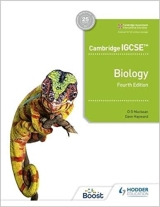Chapter 28. Ecosystems
Page 255
1. The community in woodland would consist of the different species of trees and shrubs and the birds, mammals and insects which inhabit them, plus lichens and algae. It would include the woodland flora, mosses and fungi and all the inhabitants of the soil.
2. a The earthworm’s habitat is the soil.
b Its environment could be a lawn, a garden, woodland or farmland, with its accompanying water and air. This environment might include birds and mammals which eat earthworms and the organic matter on which the worm feeds.
3. The producers could be grasses or flowering plants. The primary consumers could be herbivorous mammals or insects. Decomposers would be fungi and bacteria.
4. Plants could compete for sunlight by growing taller than their neighbours, having more branches or leaves. They could compete for water and nutrients by rapid and extensive root growth.
Page 257
1. Intraspecific competition between the wheat plants might be their growth rate and root spread.
Interspecific competition could take the same form but be between the wheat plants and competing weeds.
2. The long, bristle-fringed back legs of the water beetle would help to propel it through the water but would be a encumbrance on the land. The smooth outline of the head, thorax and abdomen might streamline it while swimming.
3. The overlapping flight feathers increase the air resistance in the downstroke. Its limb bones are hollow and, therefore, light. Many parts of the skeleton are fused and form a rigid framework which resists distortion during the muscle contraction of the downbeat. The deep breastbone provides a firm anchorage for the flight muscles. The pectoral muscles are large and powerful which allows a powerful down beat. The flight feathers are light and air-resistant.
4. a A camel reduces its water losses by absorbing water vapour from exhaled air in its nasal mucus. During inhalation the moisture returns to the lungs.
b The camel is able to withstand desiccation by the withdrawal of water from the tissues to maintain the blood volume and concentration.
5. The polar bear’s volume/mass ratio reduces the relative area exposed to heat loss. Its small ears also reduce heat losses. It has a dense coat of fur with the inner layer of densely packed hairs forming effective insulation. Heat loss from the feet is reduced by an exchange of heat between the arteries and veins of the limb. This keeps the blood in the feet cool and so it loses less heat to the snow and ice.
|
Downloads
Download the answers in PDF format below
Section 1, Chapters 1-5
Section 2, Chapters 6-9
Section 3, Chapters 10-12
Section 3, Chapters 13-17
Section 3, Chapters 18-20
Section 4, Chapters 21-24
Section 5, Chapters 25-27
Section 5, Chapters 28-29
Section 6, Chapters 30-34
Section 6, Chapters 35-37
Section 7, Chapters 38-39
Section 8, Chapters 40-41
|
